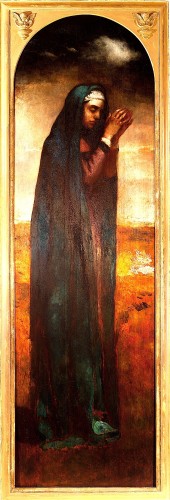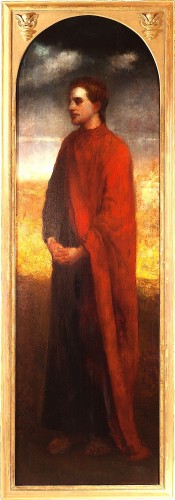It is always good, after an almost thirty-year-search, to find what you have been looking for for all of that time. And, when that search is for masterpieces by one of Green-Wood’s permanent residents, who was one of the giants of American art, the multi-faceted artist John La Farge (1835-1910), I sit up and take notice.
In 1971, William Vareika, still in college, first became acquainted with the art of John La Farge. He needed a term paper topic; La Farge was chosen. And a lifelong fascination with, and appreciation of, La Farge’s art began. Here’s how Vareika, a longtime art gallery owner, describes La Farge:
Born in New York City in 1835, painter, engraver, muralist, illustrator, lecturer, writer, and stained glass artist, John La Farge is one of the most important American artists and cultural figures of the 19th Century. La Farge studied in the Newport, Rhode Island studio of William Morris Hunt and became one of the first American artists to paint landscapes in the open air. During the 1860s he produced the first impressionist experiments on American soil and created some of the most beautiful floral still lifes ever painted. In 1876 La Farge worked with architect Henry Hobson Richardson on the interior decoration of Trinity Church in Copley Square, Boston, producing stained glass windows and monumental murals. With his work at Trinity, La Farge is considered to have initiated the American Renaissance movement. In 1886 and 1891, the artist traveled to Japan and the South Seas, producing paintings of his travels and publishing illustrated books of his adventures. La Farge’s artistic career earned him appointment to the French Legion of Honor. When the artist died in Providence, Rhode Island in 1910 he was eulogized by the art critic and biographer Royal Cortissoz as: “our sole ‘Old Master’, our sole type of genius that went out with the Italian Renaissance.”
After college, Vareika, fascinated by La Farge, abandoned law school plans to volunteer to direct a legal effort to save a La Farge-decorated church in Newport that was endangered. In order to support himself during the six years of that preservation fight, he went into business as an art dealer. As Vareika has written:
When he opened his Newport gallery in 1987, his specialty was the art of John La Farge and other important American artists who had been attracted to the Newport and Narragansett Bay region in the 18th 19th and early 20th centuries. To date, he has probably owned more artworks by John La Farge than any art dealer in history. Recently, Vareika spearheaded another La Farge preservation effort that led to the gift of 13 endangered La Farge stained glass windows to Salve Regina University in Newport, RI, where a chapel was designed and built by architect Robert A.M. Stern to house them.
I have visited William Vareika Fine Arts on beautiful and historic Bellevue Avenue in Newport, Rhode Island, several times. It is a great place for anyone interested in the work of artists who are interred at Green-Wood. There always is much by John La Farge there, but on any given visit you might find a painting by William Holbrook Beard off in that corner, another by George Bellows up there, and paintings by John George Brown, John William Casilear, Bruce Crane, Mauritz F.H. De Haas, Asher Brown Durand, George Henry Hall, Daniel Huntington, Eastman Johnson, David Johnson, John Frederick Kensett, Louis Lang, Clinton Loveridge, Samuel F. B. Morse, Charles Parson, George Henry Smillie, all of whom are interred at Green-Wood. Several years ago, when I visited, Bill gave me directions to a church in the middle of nowhere filled with stained glass windows by Louis Comfort Tiffany, another Green-Wood permanent resident. That was a real treat!
Back in 1983, still early in his fascination with La Farge, Vareika learned of the existence of two “lost” La Farge paintings: “The Virgin” and “St. John the Evangelist at the Foot of the Cross;” they were listed in a publication that he came across as “location unknown.” So Vareika’s search for them began. And, almost 30 years later, it ended in triumph: his finding the “lost” paintings and his recent purchase of them.

Here’s Vareika’s description of these paintings:
A pair of monumental historic paintings, “The Virgin” and “St. John the Evangelist at the Foot of the Cross,” painted in Newport by the famous 19th century American artist John La Farge will be exhibited for the first time in seventy-five years by William Vareika Fine Arts Ltd, located at 212 Bellevue Avenue, Newport, Rhode Island. Among the largest and most important paintings ever created by La Farge, these works were lost to the art field until recently and were last publicly shown in 1936 when they were loaned by the Whitney Museum of American Art to the Metropolitan Museum of Art for An Exhibition of the Work of John La Farge.

These artworks are part of a large triptych Crucifixion ensemble commissioned in 1862 for Saint Peter’s Roman Catholic Church in New York City. Only the two side panels, representing Saint John the Evangelist on the right and the Virgin Mary on the left, were completed by La Farge, and the altar piece was never installed in the historic church. The paintings are on thick mahogany panels each measuring 95 ½ by 29 ½ inches, with arched tops and frames adorned with gilded putti.
In designing these masterworks, perhaps the first decorative creations by the “Father” of the American mural movement, the artist drew upon 14th century Italian altarpieces for his design. La Farge expert Professor James L. Yarnall observes that “the poses and attenuated silhouettes of the figures are especially reminiscent of work from the Byzantine and Sienese schools of the late fourteenth and early fifteenth centuries.” Departing from his precedents, however, La Farge “gave the narrative a modern feeling through the introduction of an atmospheric landscape and breath-taking perspective.” The view looks east across a coastal Rhode Island landscape near Newport, where La Farge was living at the time the panels were painted. Yarnall notes that the features of Saint John are those of the artist’s close friend and Harvard psychologist and philosopher, William James, and the features of the Virgin Mary are those of the artist’s wife, Margaret Mason Perry La Farge.
Here is the provenance of these masterpieces, as put together by William Vareika:
In 1884, the paintings were purchased at Ortgies and Company in New York by William Collins Whitney for his residence in Old Westbury, Long Island, New York, at the insistence of famed architect Stanford White, and they remained in the Whitney family for many years. Gertrude Vanderbilt Whitney gifted them to the Whitney Museum at its opening in 1931. In 1934 artist and La Farge student Leon Dabo remembered that La Farge had worked for two years on this project “which remains one of his most important paintings.” In 1950, when the Whitney Museum determined to limit its collection to 20th century American art, they were sold by Knoedler and Company to Cornelius Vanderbilt Whitney. Apparently, the works were hung in Whitney’s palatial residence in Trujillo, Spain until 1983 when they were acquired by his legendary Madrid decorator Duarte Pinto Coehlo for his home in Trujillo, a former convent. Coehlo died last year and in July his possessions were sold in a country house sale in London. The paintings were acquired at that sale by Vareika and have been returned to the U.S. and conserved.
Always good to find what you are looking for, even if it takes a few decades to do so.
And one final note: on our Green-Wood at The Met Day Trip, next week (March 15), we will see two great stained glass windows by John La Farge, and several by Louis Comfort Tiffany. Two men pioneered stained glass in America in the late 19th century: La Farge and Tiffany. Both are interred at Green-Wood.